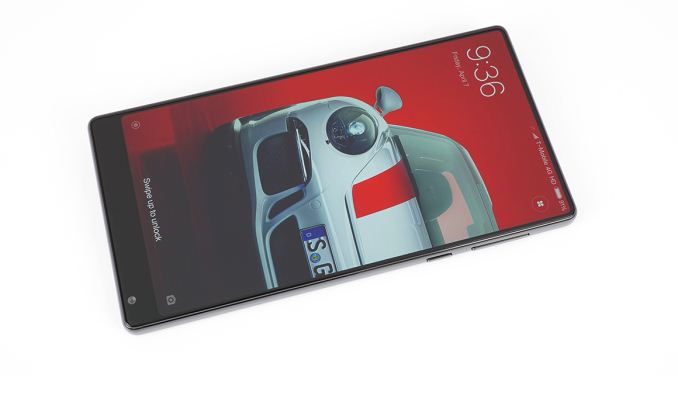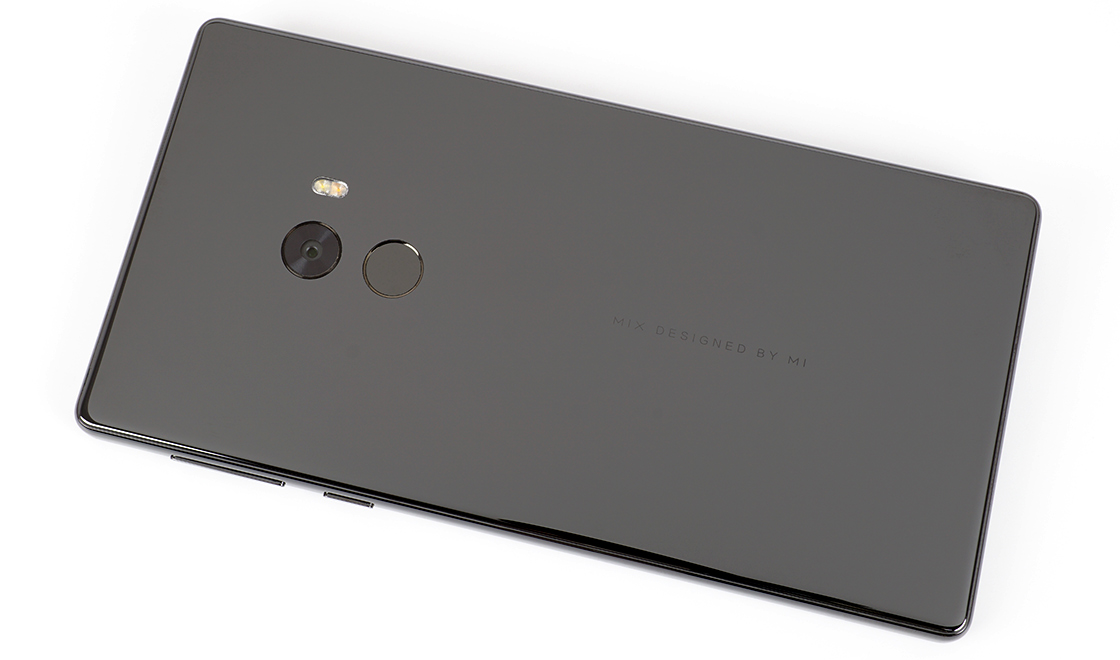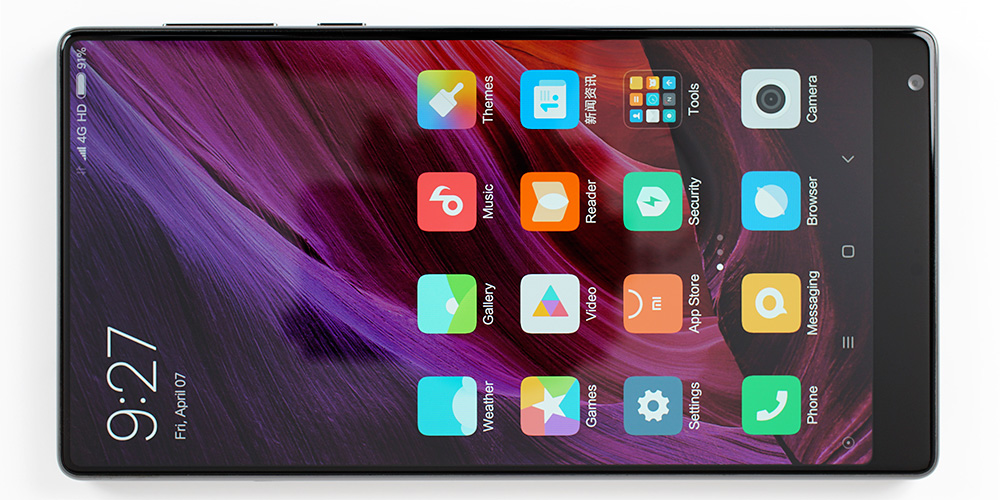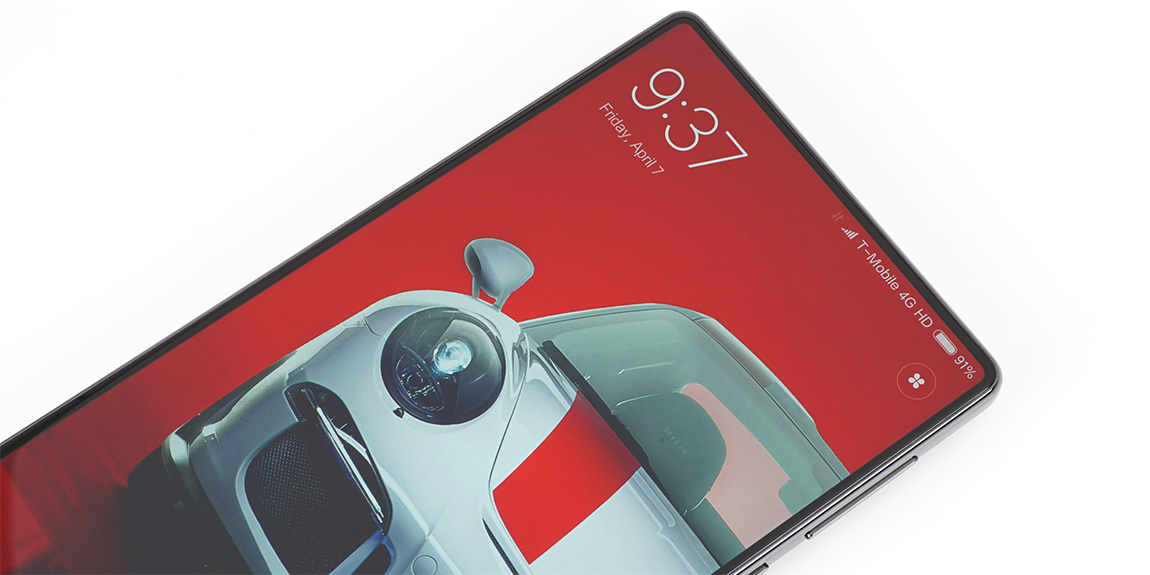Xiaomi Mi MIX: A Closer Look at the Design and Display
by Matt Humrick on April 10, 2017 7:00 AM EST- Posted in
- Smartphones
- Mobile
- Xiaomi
- Mi
- Snapdragon 821

We recently saw the release of two new smartphones with dramatically improved screen-to-body ratios, the LG G6 and Samsung Galaxy S8. Before either of these phones were announced, however, Xiaomi’s Mi MIX gave us a glimpse of the future. A pseudo-concept phone that’s being produced in limited quantities and sold in China, it combines the latest technology with innovative design, resulting in a forward-looking phone with virtually no bezels on three sides of the screen and an amazing 91.3% screen-to-body ratio, according to Xiaomi (or roughly 84% using the chassis dimensions).
Xiaomi created the Mi MIX to show off its design prowess and demonstrate its ability to produce innovative products. Xiaomi has employed new materials (ceramic) and design elements (rounded edges on the back) in the past, but by creating something as unique as the MIX, it hopes to prove that its products are as lust worthy as those that come from Apple and Samsung.
Competition among Chinese OEMs is fierce, with most of them sacrificing smartphone profit for market share. Xiaomi in particular has a reputation for creating nice-looking phones packed with high-performing hardware that are sold at lower-than-expected prices, compensating for the near-zero profit from hardware sales with recurring revenue earned through its software ecosystem. This strategy has helped fuel its rapid growth, but as the smartphone market in Asia nears saturation, it may be time to shift its focus. Xiaomi has been aggressively diversifying its product portfolio, branching out into smart home devices, UAVs, bicycles, etc., and pushing into western markets where premium phones fetch higher profit. By creating a flashy product like the MIX, Xiaomi attracts attention and improves its brand cachet, which can help it break into new markets and establish itself as a premium player that can charge more for its phones.
Encased within the shiny ceramic is a Snapdragon 821 SoC and a large 4400 mAh battery. There’s also either 4GB of RAM and 128GB of internal storage for the standard MIX or 6GB of RAM and 256GB of storage for the Mi MIX 18K. Both configurations offer flagship-class performance.
In the short time I’ve used the MIX, the only component I’ve had issues with is the fingerprint sensor. It seems less tolerant of moisture than other sensors and returns a higher rate of false negatives. It’s certainly usable, but I often found it required two or three tries to unlock the phone.
| Xiaomi Mi MIX | |
| SoC | Qualcomm Snapdragon 821 (MSM8996 Pro) 2x Kryo @ 2.35GHz 2x Kryo @ 2.19GHz Adreno 530 @ 653MHz |
| Display | 6.4-inch 2040x1080 IPS LCD |
| Dimensions | 158.8 x 81.9 x 7.9 mm 209 grams |
| RAM | 4GB / 6GB LPDDR4 |
| NAND | 128GB / 256GB (UFS 2.0) |
| Battery | 4400 mAh (16.94 Wh) non-replaceable Qualcomm Quick Charge 3.0 |
| Front Camera | 5MP, 1/5" OmniVision OV5675 PureCel, 1.12µm pixels, f/2.2 |
| Rear Camera | 16MP, 1/3.06" OmniVision OV16880 PureCel Plus-S, 1.0µm pixels, f/2.0, PDAF, Auto HDR, dual-tone LED flash |
| Modem | Qualcomm X12 LTE (Integrated) 2G / 3G / 4G LTE (Category 13/12) |
| SIM Size | 2x NanoSIM (dual standby) |
| Network | China |
| FDD-LTE | B1 / B2 / B3 / B4 / B5 / B7 / B8 |
| TDD-LTE | B38 / B39 / B40 / B41 |
| GSM | 850 / 900 / 1800 / 1900 |
| WCDMA | B1 / B2 / B5 / B8 |
| CDMA | BC0 |
| TD-CDMA | B34 / B39 |
| Wireless | 802.11a/b/g/n/ac 2x2 MU-MIMO, BT 4.2, NFC, GPS/GNSS/Beidou |
| Connectivity | USB Type-C, 3.5mm headset |
| Launch OS | Android 6.0 with MIUI 8 |
| Launch Price | 4GB/128GB: ¥3499 6GB/256GB: ¥3999 |
The MIX’s 6.4-inch IPS LCD display has a 17:9 aspect ratio, which Xiaomi divides into a traditional 16:9 viewable area with a dedicated space at the bottom of the screen for the onscreen controls. Not only does this eliminate the need for capacitive buttons in the lower bezel—keeping it as slim as possible—but it avoids UI scaling issues for apps targeting 16:9 screens.
Our review unit uses a Sharp fte716 IPS LCD panel that appears to use IGZO (indium gallium zinc oxide) thin-film transistors (TFTs) in the backplane. IGZO transistors have several advantages over the amorphous silicon (aSi) or low-temperature polysilicon (LTPS) varieties.
Every liquid crystal (LC) requires circuitry, including a transistor and a capacitor, to control its operation. These components can block some of the light transmission from the backlight, however, reducing the display’s power efficiency. The more light that passes through the backplane, the less power the backlight needs to consume to reach a given brightness.
Most IPS LCD panels use aSi TFTs. These are not naturally transparent, although, they can be made thin enough to allow at least some light to pass through them. IGZO TFTs, however, are fully transparent, which improves power efficiency by allowing more light to pass through.
IGZO’s electron mobility is also significantly higher than aSi and almost as good as LTPS, which allows smaller transistors to carry the same current. The MIX’s panel uses the smaller TFTs to increase the aperture ratio (the ratio of a pixel’s transparent and opaque areas), which further improves efficiency by allowing more light to pass through.
Most LCD displays need to continually refresh the screen, even when displaying a static image, because high leakage current in aSi and LTPS TFTs causes the capacitors in the pixels to discharge. Continuously driving the pixels in this manner increases power consumption, not just within the panel itself, but also by forcing the SoC to continuously push the contents of the frame buffer over the memory bus. To help mitigate this issue, some panels support panel self-refresh (PSR), which embeds a small amount of RAM in the panel itself to hold a local copy of the frame buffer. When displaying a static image (which is most of the time when not playing a game or watching a video), the panel can use its local copy to refresh the screen, reducing the power the SoC and busses would normally consume.
The Mi MIX’s panel does not support panel self-refresh, which would normally be a serious omission for a flagship phone; however, IGZO TFTs have significantly less leakage current than aSi and LTPS, allowing their pixels to discharge more slowly and retain their image state longer. A technology called idling-stop driving (IDS) takes advantage of this by significantly reducing the refresh rate of the screen when displaying static content, essentially achieving a similar power advantage as a display with PSR.
IGZO’s benefits not only reduce a display’s power consumption, but they are directly responsible for the Mi MIX’s most eye-catching feature: its edge-to-edge display. IGZO allowed Sharp to integrate the supporting circuitry that normally surrounds the active area of the screen into the panel itself, allowing Xiaomi to nearly eliminate the bezel on three sides.
The Mi MIX is a stunning looking phone whose nearly edge-to-edge display and shiny ceramic body make it stand out as something special. Xiaomi’s use of ultrasonic and piezoelectric technology streamlines the front by hiding two components—proximity sensor and earpiece speaker—behind the screen, fueling the illusion that you’re holding nothing but a 6.4-inch display. As the phone’s centerpiece, display performance is critical for the Mi MIX, and our analysis on the next page shows that it looks as good as the rest of the phone.













48 Comments
View All Comments
Daniel Egger - Tuesday, April 11, 2017 - link
> You for example trust the Chinese and their hackware over Google services.No, you got that all wrong. I trust neither the Chinese nor Google which is why I only buy Android devices if LineageOS is available...
niva - Thursday, April 13, 2017 - link
I was stating my preference, though I agree with you in principle. Google scares me in terms of the access to information they now have and the capability for abuse. So far they seem to be very careful in terms of managing their priorities and policies to work in the public interest while also banking crazy profits. Ultimately they provide their services for free though, it's up to you if you want to use them.niva - Thursday, April 13, 2017 - link
Oh looks like I touched a nerve there.I was referring to previous cases where Chinese versions of Android were modified to report data back home. I'm weary of Google too, but a lot more eyes are looking at what they do, and the code they publish, until they betray the interest of the public I'll play along. You don't get that from the Chinese firms. As I stated in my post, I like the Nexus 6P, this has little to do with racism but if you want to call it that so be it.
Glock24 - Monday, April 10, 2017 - link
I have a Redmi Note 3 "Special Edition", which to my knowledge is the first "global" phone by Xiaomi. It came preloaded with Google services, and if fact, if the only phone in Xiamomi's lineup that does not have a chinese firmware.Xiaomi is expanding to new markets, so many newer phones have a "Global Firmware" that includes Google services. To name a few, Redmi 4 and Redmi Note 4 have a "Global Firmware". Now, LTE band support is another matter.
Mishuno - Monday, April 10, 2017 - link
I have a Mi 5 which I bought from a third party re-seller as soon as it was released last year, was using a 4c before that. I immediately unlocked the phone through Xiaomi unlock tool, wiped the phone and installed the global MIUI 8 Developer variant. It comes loaded with all Google services, all menus' etc.. are all in English and all Chinese bloatware is removed. I was able to choose USA as my region. I get weekly updates and it is constantly being improved. It works great in PA on AT&T. I get many compliments from people when they notice the phone.fm13 - Tuesday, April 11, 2017 - link
how's headphone volume level on Dev ROM? it's too low on Global Stable for me.lordken - Saturday, April 22, 2017 - link
@m4r1k: well you claim you had many devices but I wonder how you can say such things about miui. I've come to Xiaomi last year and as far as I remember MI4 variants had global ROM, and MI5 definitely has global ROM, global rom means google ware installed by default. Most of devices (if not all) does have global roms, although not immediately after phone release.Personally I'm using EU rom (which are based on cn and tweaked a little) as I don't want to have all google stuff installed which I don't use in system. Plus it has some tweaks over lame global verions. Ofc disadvantage is that you need to have unlocked BL (on new phones) which makes it easier for thieves to reuse your phone...
Also it is pretty much untrue that xiaomi EU (fan made btw) doesn't provide stable versions. They does, probably from very beginning.
Also big plus for Xiaomi is that they keep updating old devices like redmi2 that has like almost 3 years.
And as for China concern, well I rather "trust" CN then west/US, so I'm more happy if CN has my data rather then west, because as simple as it is, CN influence in the west is minimal, ie I cant see how they can misuse my data. But as living in EU (or US) we are more vulnerable from data collected by google and other companies because we live in the same "system" (doesn't mean I approve data collection and spying)
But sure Xiaomi isn't ideal, they release too much devices, which slows them down in miui updates, and they mostly focus on stupid cosmetic things rather then fixing real issues. But at least they tend to update android security patches quite often.
daiwai - Monday, April 10, 2017 - link
I know Japanese phone aka keitai is not well known, but please give some credit back to Sharp as it's AQUOS Crystal line is probably the earliest bezel-less phone.http://www.gsmarena.com/sharp_aquos_crystal_and_cr...
Qwertsun - Monday, April 10, 2017 - link
I do agree with you on this. I dare say that Sharp is the reason why Mi Mix stands out; Sharp's know how on making bezeless screens.jabber - Monday, April 10, 2017 - link
I like the look of all these phones but I just wonder about what little 'software extras' are hidden away in the back there.